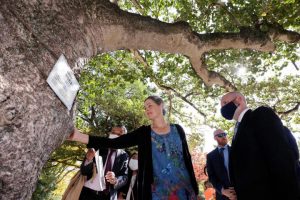Five US scientists look over A-bombed trees and meet with Hiroshima City mayor
Nov. 8, 2022
by Kana Kobayashi, Staff Writer
On November 7, five scientists from the United States representing the fields of botany and biology carried out inspections of A-bombed trees remaining on the grounds of Hiroshima Castle, located in the city’s Naka Ward. With the aim of learning more about the ecology of the trees that withstood the devastation from the atomic bombing 77 years ago, the visit was the group’s first to the A-bombed city of Hiroshima. The scientists were able to come into contact with the life energy of the “silent witnesses,” such as the trees, that remain in the city.
Ari Novy, 44, president and CEO of San Diego Botanic Garden in the U.S. state of California, together with the other scientists, confirmed the characteristics of A-bombed eucalyptus and Kurogane holly trees considered to have been affected by radiation exposure. Accompanying the scientists on their visit was Chikara Horiguchi, 77, an arborist who is a resident of Hiroshima’s Nishi Ward. Mr. Horiguchi explained to the group, “The scars from the A-bomb blast remain on the trees. In the case of ordinary trees, the passage of 70 years would have been long enough for them to completely recover.”
The scientists later met with Hiroshima City Mayor Kazumi Matsui at Hiroshima City Hall. Mr. Matsui introduced an initiative led by the Mayors for Peace organization involving the sending of seeds from A-bombed trees to other nations throughout the world and asked the scientists to help promote the activity in the United States. Mr. Novy and others reported that they were cultivating the seeds of A-bombed trees that had been sent from citizens groups in Hiroshima and were distributing the seedlings in locales across the United States.
During the time spent looking over the trees, Mr. Novy suggested that the information gleaned by the group could be connected to botanical research at the genetic level, among other ideas. He added his desire for people to learn about past events through trees and, in so doing, take advantage of the opportunity to consider issues of peace and hope.
(Originally published on November 8, 2022)
On November 7, five scientists from the United States representing the fields of botany and biology carried out inspections of A-bombed trees remaining on the grounds of Hiroshima Castle, located in the city’s Naka Ward. With the aim of learning more about the ecology of the trees that withstood the devastation from the atomic bombing 77 years ago, the visit was the group’s first to the A-bombed city of Hiroshima. The scientists were able to come into contact with the life energy of the “silent witnesses,” such as the trees, that remain in the city.
Ari Novy, 44, president and CEO of San Diego Botanic Garden in the U.S. state of California, together with the other scientists, confirmed the characteristics of A-bombed eucalyptus and Kurogane holly trees considered to have been affected by radiation exposure. Accompanying the scientists on their visit was Chikara Horiguchi, 77, an arborist who is a resident of Hiroshima’s Nishi Ward. Mr. Horiguchi explained to the group, “The scars from the A-bomb blast remain on the trees. In the case of ordinary trees, the passage of 70 years would have been long enough for them to completely recover.”
The scientists later met with Hiroshima City Mayor Kazumi Matsui at Hiroshima City Hall. Mr. Matsui introduced an initiative led by the Mayors for Peace organization involving the sending of seeds from A-bombed trees to other nations throughout the world and asked the scientists to help promote the activity in the United States. Mr. Novy and others reported that they were cultivating the seeds of A-bombed trees that had been sent from citizens groups in Hiroshima and were distributing the seedlings in locales across the United States.
During the time spent looking over the trees, Mr. Novy suggested that the information gleaned by the group could be connected to botanical research at the genetic level, among other ideas. He added his desire for people to learn about past events through trees and, in so doing, take advantage of the opportunity to consider issues of peace and hope.
(Originally published on November 8, 2022)








